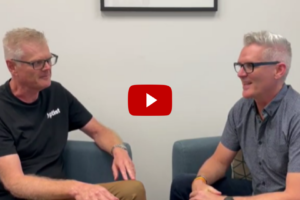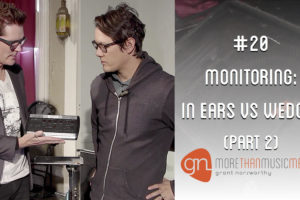Grant spoke with Dominic Schryvers from The Stations and the Gregorian Chat YouTube Channel about…
M3 VIDEO #12 – ELECTRIC GUITAR, ACOUSTIC GUITAR & KEYS: WHO’S DRIVING?
By Grant Norsworthy
Many Church bands today feature electric guitar, acoustic guitar and keyboard. Each of these three instruments is capable of playing full chords in a rhythm that drives the song arrangement along. But what happens when two, or even all three of these instruments try to drive the song at the same time?
Watch this short training video. To understand the thought process behind the training video, read the blog post below it.
Many Church bands today feature electric guitar, acoustic guitar and keyboard. Each of these three instruments is capable of playing full chords in a rhythm that drives the song arrangement along. But what happens when two, or even all three of these instruments try to drive the song at the same time?
Watch this short training video. To understand the thought process behind the training video, read the blog post below it.
The video above is #12 in the More Than Music Mentor training resource series.
When two, or even all three of these chordal instruments try to be the driving element of a song arrangement, the most likely outcome is a wreck. Too many hands fighting over the steering wheel! We tend to get a lot of distracting, unmusical clutter and mess. This din is what I sometimes call “sonic soup” and should be eradicated if the band is to craft an inviting sound to support congregational singing as an expression of worship.
To be clear: When I use the term “driving” in this context, I mean an instrumental part that is providing the most dynamic, energetic, rhythmic playing. It’s the chordal instrument that moves the song along most and clearly establishes the accompanying chord at a given moment in the song. In most Church music situations, there is only room for one driving, chordal instrument. No more.
The way the fingers of a pianist play notes on a keyboard is very different from the way a guitarist’s hand strums or plucks a guitar. The contrasting techniques that are utilized to activate notes from one instrument to the other means that the two can be difficult to combine as one coherent sound. The more driven and busy each instrument is, the more likely it is that the sound of each instrument will become mismatched and incompatible with the other.
This “sonic soup” producing problem is further exasperated with less capable instrumentalists who play without good timing. Now there are many notes landing at random time intervals, “flamming” with one another in unmusical ways that do not relate to the actual rhythm of the song! Even seasoned, professional keyboardists and guitarists can struggle to play two driving parts together that are truly coherent. Such a task is not possible, nor necessary, with Church volunteer musicians.
It’s important for the whole band – especially those members who play chordal instruments – to understand this “Who’s driving?” concept. During the practicing and arranging stage of a songs preparation, speak about who is driving. We must learn to allow one chordal instrument to drive while the others (musically speaking) take a passengers’ seat by playing a supporting, simpler, more spacious part. With an intentional approach, focus, practice, and the development of the ability to listen better to one another, this will begin to become natural and soon may not need to be spoken about at all.
In some situations, the band might always be driven by one of these three instruments. Is your band piano driven for every song and every part of the song? Perhaps it’s acoustic guitar driven always? This can become the default with a leader – who may well be the most accomplishes instrumentalist – playing the driving instrument. They try to keep the band together by driving constantly.
This may be a necessary starting point for many bands, but if we are going to create an inviting sound with color, interest, variation and artistry, we ought to allow the driver’s role to shift from one song to another and even one section of a song to another. Perhaps the intro and verses could be acoustic driven, the choruses electric driven and then that softer, emotive bridge could be driven by keyboards.
Explore the possibilities. Share the driving role. Develop less experienced players by allowing them to drive a simple section and then a whole song. Listen to one another. Use what works best. But always know who is driving.
As we do this, we will leave space in our band sound that makes it clear to the congregation that we are inviting them to sing with us. They must be encouraged to step into their essential role of expressing the worth of God – worshiping God – through the songs we play.
In this instructional video for Church musicians I speak with electric guitarist Evan Redwine and pianist Zach Vinson about the need to establish one main driving chordal instrument in a song’s arrangement.
Watch Video#12 – Electric Guitar, Acoustic Guitar & Keys: Who’s Driving? again.
For more free resource videos and info, visit www.MoreThanMusicMentor.com.
And if your looking to purchase an acoustic guitar, you should first check out this great article from Beginner Guitar HQ. It’s a comprehensive buyers guide!


